Authorization
When you share access to Avo with your clients or large teams, you may want to restrict access to a resource or a subset of resources. One example may be that only admin-level users may delete or update records.
By default, Avo leverages Pundit under the hood to manage the authorization.
Pundit alternative
Pundit is just the default choice. You may plug in your own client using the instructions here.
WARNING
You must manually require pundit or your authorization library in your Gemfile.
# Minimal authorization through OO design and pure Ruby classes
gem "pundit"Ensure Avo knows who your current user is
Before setting any policies up, please ensure Avo knows your current user. Usually, this 👇 set up should be fine, but follow the authentication guide for more information.
# config/initializers/avo.rb
Avo.configure do |config|
config.current_user_method = :current_user
endPolicies
Just run the regular pundit bin/rails g pundit:policy Post to generate a new policy.
If this is a new app you need to install pundit first bin/rails g pundit:install.
With this new policy, you may control what every type of user can do with Avo. The policy has the default methods for the regular controller actions: index?, show?, create?, new?, update?, edit? and destroy?.
These methods control whether the resource appears on the sidebar, if the view/edit/destroy buttons are visible or if a user has access to those index/show/edit/create pages.
-> index?
index? is used to display/hide the resources on the sidebar and restrict access to the resources Index view.
INFO
This option is used in the auto-generated menu, not in the menu editor.
You'll have to use your own logic in the visible block for that.
-> show?
When setting show? to false, the user will not see the show icon on the resource row and will not have access to the Show view of a resource.
-> create?
The create? method will prevent the users from creating a resource. That will also apply to the Create new {model} button on the Index, the Save button on the /new page, and Create new {model} button on the association Show page.
-> new?
The new? method will control whether the users can save the new resource. You can also access the record variable with the form values pre-filled.
-> edit?
edit? to false will hide the edit button on the resource row and prevent the user from seeing the edit view.
-> update?
update? to false will prevent the user from updating a resource. You can also access the record variable with the form values pre-filled.
-> destroy?
destroy? to false will prevent the user from destroying a resource and hiding the delete button.
More granular file authorization
These are per-resource and general settings. If you want to control the authorization per individual file, please see the granular settings.
-> act_on?
Controls whether the user can see the actions button on the Index page.
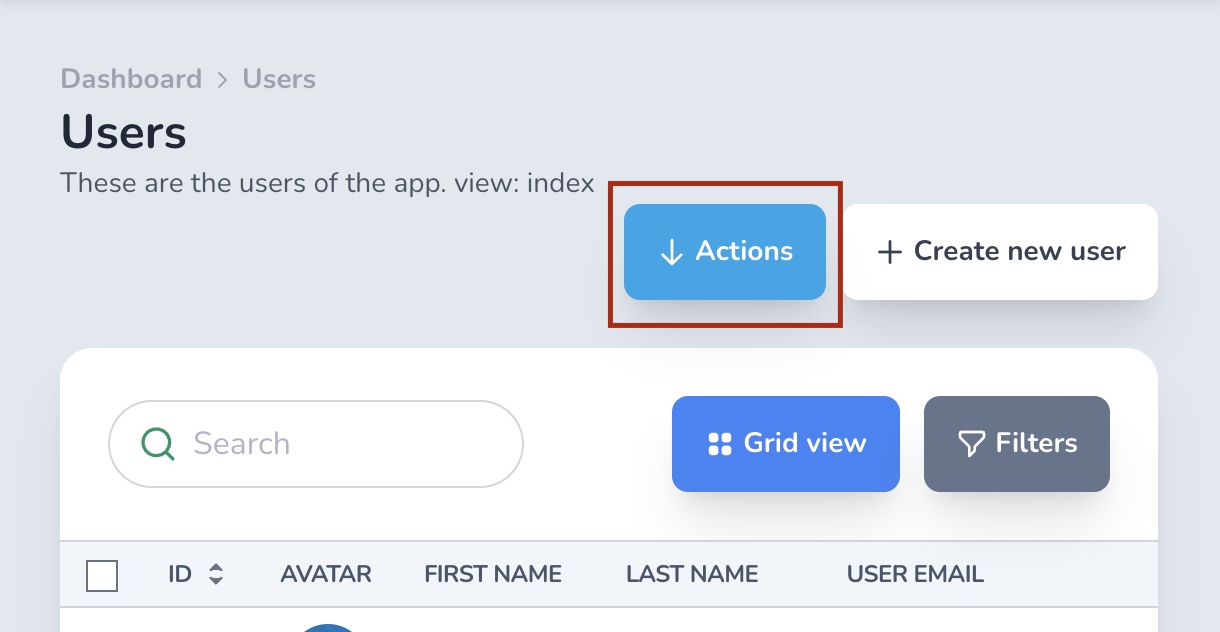
-> reorder?
Controls whether the user can see the records reordering buttons on the Index page.
When using associations, you would like to set policies for creating new records on the association, allowing to attach, detach, create or destroy relevant records. Again, Avo makes this easy using a straightforward naming schema.
WARNING
Make sure you use the same pluralization as the association name.
For a has_many :users association use the plural version method view_users?, edit_users?, detach_users?, etc., not the singular version detach_user?.
Example scenario
We'll have this example of a Post resource with many Comments through the has_many :comments association.
The record variable in policy methods
In the Post has_many Comments example, when you want to authorize show_comments? in PostPolicy you will have a Comment instance as the record variable, but when you try to authorize the attach_comments?, you won't have that Comment instance because you want to create one, but we expose the parent Post instance so you have more information about that authorization action that you're trying to make.
-> attach_{association}?
Controls whether the Attach comment button is visible. The record variable is the parent record (a Post instance in our scenario).
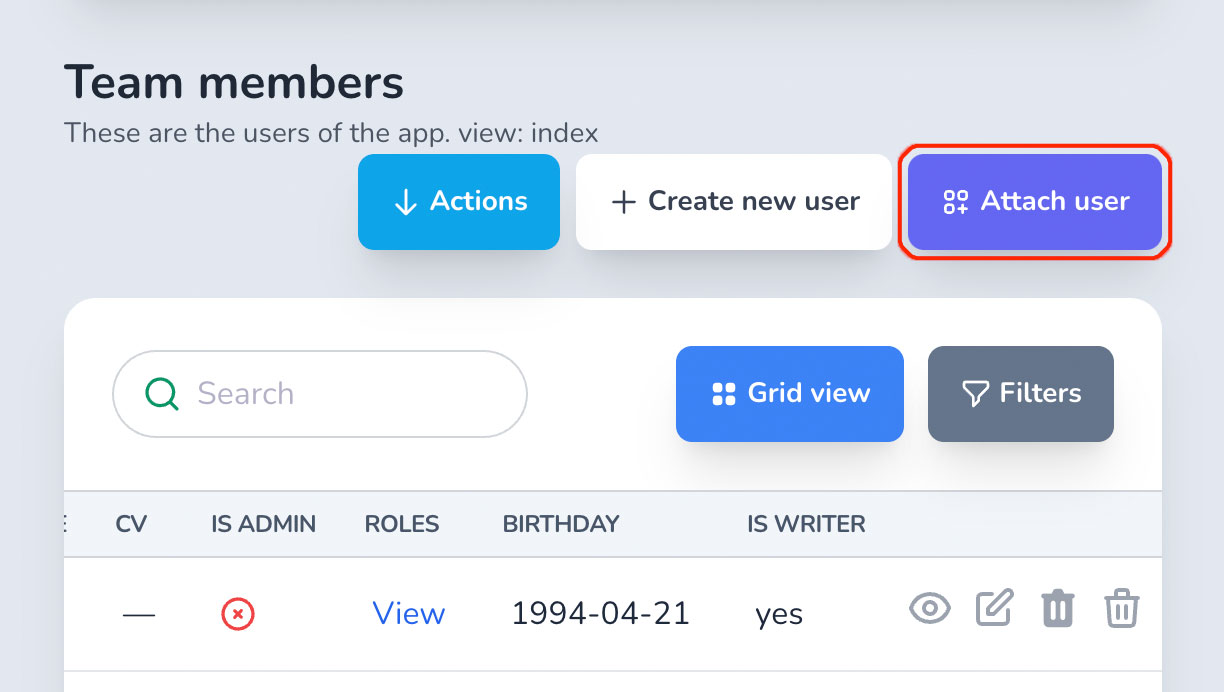
-> detach_{association}?
Controls whether the detach button is available on the associated record row on the Index view. The record variable is the actual row record (a Comment instance in our scenario).
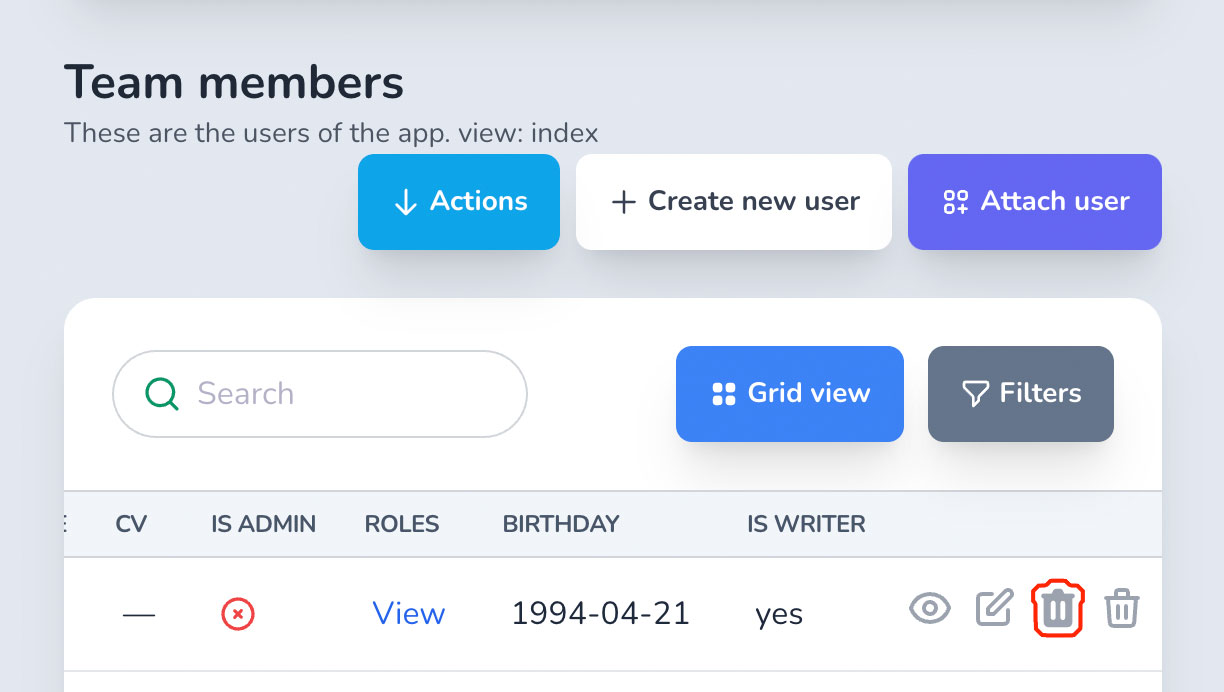
-> view_{association}?
Controls whether the whole association is being displayed on the parent record. The record variable is the actual row record (a Comment instance in our scenario).
-> show_{association}?
Controls whether the view button is visible on the associated record row on the Index page. The record variable is the actual row record (a Comment instance in our scenario).
WARNING
This does not control whether the user has access to that record. You control that using the Policy of that record (PostPolicy.show? in our example).

Difference between view_{association}? and show_{association}?
Let's take a Post has_many Comments.
When you use the view_comments? policy method you get the Post instance as the record and you control if the whole listing of comments appears on that record's Show page.
When you use show_comments? policy method, the record variable is each Comment instance and you control whether the view button is displayed on each individual row.
-> edit_{association}?
Controls whether the edit button is visible on the associated record row on the Index page.The record variable is the actual row record (a Comment instance in our scenario).
WARNING
This does not control whether the user has access to that record's edit page. You control that using the Policy of that record (PostPolicy.show? in our example).

-> create_{association}?
Controls whether the Create comment button is visible. The record variable is the parent record (a Post instance in our scenario).

-> destroy_{association}?
Controls whether the delete button is visible on the associated record row on the Index page.The record variable is the actual row record (a Comment instance in our scenario).
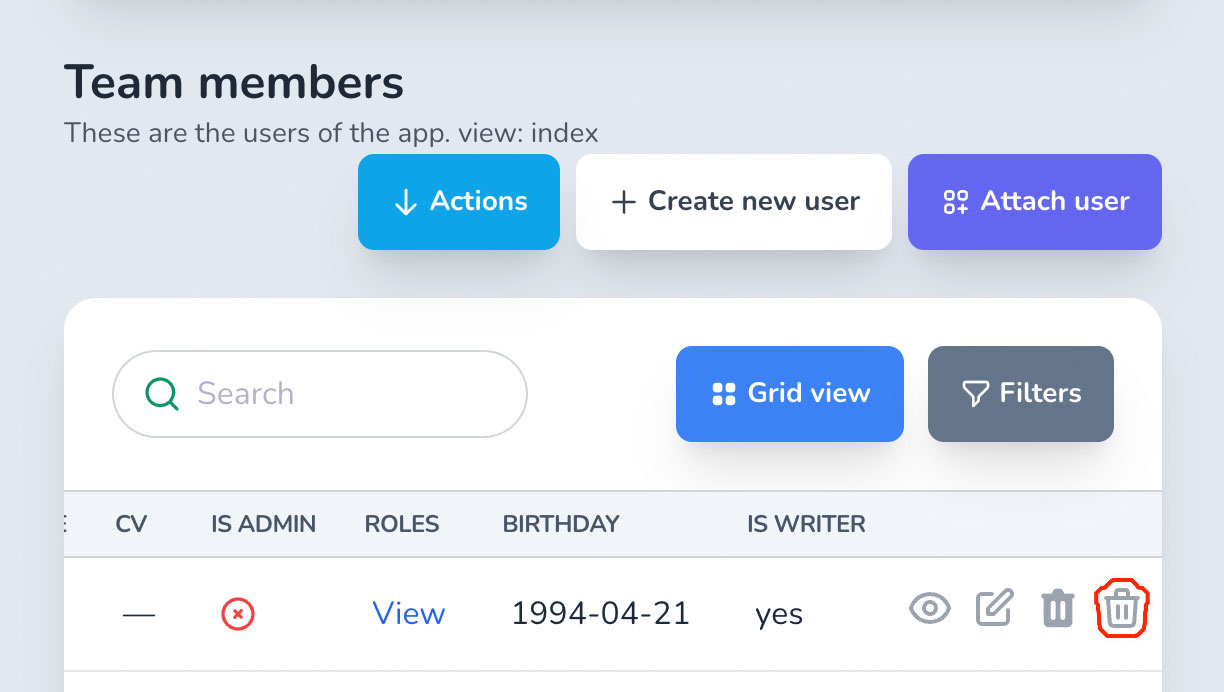
-> act_on_{association}?
Controls whether the Actions dropdown is visible. The record variable is the parent record (a Post instance in our scenario).
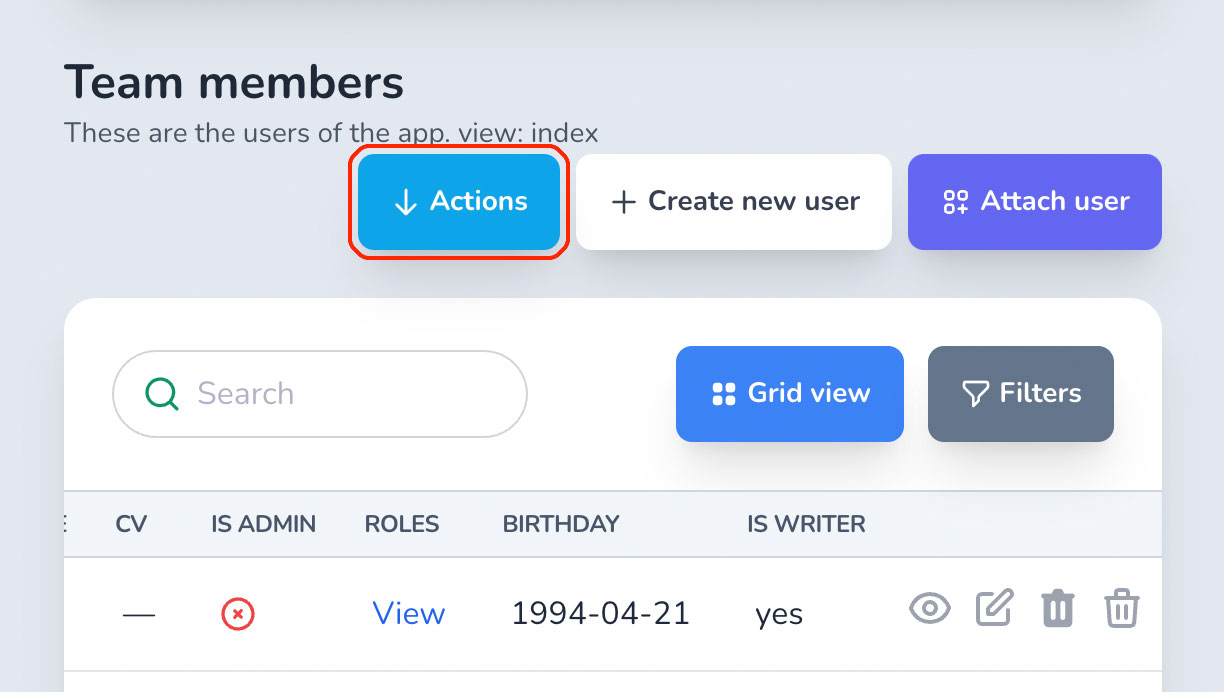
-> reorder_{association}?
Controls whether the user can see the records reordering buttons on the has_many Index page.
Removing duplication
A note on duplication
Let's take the following example:
A User has many Contracts. And you represent that in your Avo resource. How do you handle authorization to the ContractResource?
For one, you set the ContractPolicy.index? and ContractPolicy.edit? methods to false so regular users don't have access to all contracts (see and edit), and the UserPolicy.view_contracts? and UserPolicy.edit_contracts? set to false, because, when viewing a user you want to see all the contracts associated with that user and don't let them edit it.
You might be thinking that there's code duplication here. "Why do I need to set a different rule for UserPolicy.edit_contracts? when I already set the ContractPolicy.edit? to false? Isn't that going to take precedence?"
Now, let's imagine we have a user that is an admin in the application. The business need is that an admin has access to all contracts and can edit them. This is when we go back to the ContractPolicy.edit? and turn that to true for the admin user. And now we can separately control who and where a user can edit a contract.
You may remove duplication by applying the same policy rule from the original policy.
class CommentPolicy
# ... more policy methods
def edit
record.user_id == current_user.id
end
end
class PostPolicy
# ... more policy methods
def edit_comments?
Pundit.policy!(user, record).edit?
end
endNow, whatever action you take for one comment, it will be available for the edit_comments? method in PostPolicy.
From version 2.31 we introduced a concern that removes the duplication and helps you apply the same rules to associations. You should include Avo::Concerns::PolicyHelpers in the ApplicationPolicy for it to be applied to all policy classes.
PolicyHelpers allows you to use the method inherit_association_from_policy. This method takes two arguments; association_name and the policy file you want to be used as a template.
inherit_association_from_policy :comments, CommentPolicyWith just one line of code, it will define the following methods to policy your association:
def create_comments?
CommentPolicy.new(user, record).create?
end
def edit_comments?
CommentPolicy.new(user, record).edit?
end
def update_comments?
CommentPolicy.new(user, record).update?
end
def destroy_comments?
CommentPolicy.new(user, record).destroy?
end
def show_comments?
CommentPolicy.new(user, record).show?
end
def reorder_comments?
CommentPolicy.new(user, record).reorder?
end
def act_on_comments?
CommentPolicy.new(user, record).act_on?
end
def view_comments?
CommentPolicy.new(user, record).index?
endAlthough these methods won't be visible in your policy code, you can still override them. For instance, if you include the following code in your CommentPolicy, it will be executed in place of the one defined by the helper:
inherit_association_from_policy :comments, CommentPolicy
def destroy_comments?
false
endAttachments
Since v2.28When working with files, it may be necessary to establish policies that determine whether users can upload, download or delete files. Fortunately, Avo simplifies this process by providing a straightforward naming schema for these policies.
Both the record and the user will be available for you to access.

-> upload_{FIELD_ID}?
-> download_{FIELD_ID}?
-> delete_{FIELD_ID}?
AUTHORIZE IN BULK
If you want to allow or disallow these methods in bulk you can use a little meta-programming to assign all the same value.
[:cover_photo, :audio].each do |file|
[:upload, :download, :delete].each do |action|
define_method "#{action}_#{file}?" do
true
end
end
end-> upload_attachments?
DEPRECATED since 2.30.1
This option was removed in Avo 2.30.1 in favor of upload_{FIELD_ID}? method where FIELD_ID is the ID of the attachment field (ex: for has_one_attached :photo you need to declare the upload_photo? method).
Controls whether the attachment upload input should be visible in the File and Files fields.
-> download_attachments?
DEPRECATED since 2.30.1
This option was removed in Avo 2.30.1 in favor of download_{FIELD_ID}? method where FIELD_ID is the ID of the attachment field (ex: for has_one_attached :photo you need to declare the download_photo? method).
Controls whether the attachment download button should be visible in the File and Files fields.
-> delete_attachments?
DEPRECATED since 2.30.1
This option was removed in Avo 2.30.1 in favor of delete_{FIELD_ID}? method where FIELD_ID is the ID of the attachment field (ex: for has_one_attached :photo you need to declare the delete_photo? method).
Controls whether the attachment delete button should be visible in the File and Files fields.
Scopes
You may specify a scope for the Index, Show, and Edit views.
class PostPolicy < ApplicationPolicy
class Scope < Scope
def resolve
if user.admin?
scope.all
else
scope.where(published: true)
end
end
end
endWARNING
This scope will be applied only to the Index view of Avo. It will not be applied to the association view.
Example:
A Post has_many Comments. The CommentPolicy::Scope will not affect the has_many field. You need to add the scope option to the has_many field where you can modify the query.
Using different policy methods
By default Avo will use the generated Pundit methods (index?, show?, create?, new?, update?, edit? and destroy?). But maybe, in your app, you're already using these methods and would like to use different ones for Avo. You may want override these methods inside your configuration with a simple map using the authorization_methods key.
Avo.configure do |config|
config.root_path = '/avo'
config.app_name = 'Avocadelicious'
config.license = 'pro'
config.license_key = ENV['AVO_LICENSE_KEY']
config.authorization_methods = {
index: 'avo_index?',
show: 'avo_show?',
edit: 'avo_edit?',
new: 'avo_new?',
update: 'avo_update?',
create: 'avo_create?',
destroy: 'avo_destroy?',
search: 'avo_search?',
}
endNow, Avo will use avo_index? instead of index? to manage the Index view authorization.
Raise errors when policies are missing
The default behavior of Avo is to allow missing policies for resources silently. So, if you have a User model and a UserResource but don't have a UserPolicy, Avo will not raise errors regarding missing policies and authorize that resource.
If, however, you need to be on the safe side of things and raise errors when a Resource is missing a Policy, you can toggle on the raise_error_on_missing_policy configuration.
# config/initializers/avo.rb
Avo.configure do |config|
config.root_path = '/avo'
config.app_name = 'Avocadelicious'
config.license = 'pro'
config.license_key = ENV['AVO_LICENSE_KEY']
config.raise_error_on_missing_policy = true
endNow, you'll have to provide a policy for each resource you have in your app, thus making it a more secure app.
Custom policies
Since v2.17By default, Avo will infer the policy from the model of the resource object. If you wish to use a different policy for a given resource, you can specify it directly in the resource using the authorization_policy option.
class PhotoCommentResource < Avo::BaseResource
self.model_class = ::Comment
self.authorization_policy = PhotoCommentPolicy
# ...
endCustom authorization clients
INFO
Check out the Pundit client for reference.
Change the authorization client
In order to use a different client change the authorization_client option in the initializer.
The built-in possible values are nil and :pundit.
When you create your own client, pass the class name.
# config/initializers/avo.rb
Avo.configure do |config|
config.authorization_client = 'Services::AuthorizationClients::CustomClient'
endClient methods
Each authorization client must expose a few methods.
-> authorize
Receives the user, record, action, and optionally, the policy_class (you may want to use custom policy classes for some resources).
# Pundit example
def authorize(user, record, action, policy_class: nil)
Pundit.authorize(user, record, action, policy_class: policy_class)
rescue Pundit::NotDefinedError => error
raise NoPolicyError.new error.message
rescue Pundit::NotAuthorizedError => error
raise NotAuthorizedError.new error.message
end-> policy
Receives the user and record and returns the policy to use.
def policy(user, record)
Pundit.policy(user, record)
end-> policy!
Receives the user and record and returns the policy to use. It will raise an error if no policy is found.
def policy!(user, record)
Pundit.policy!(user, record)
rescue Pundit::NotDefinedError => error
raise NoPolicyError.new error.message
end-> apply_policy
Receives the user, record, and optionally, the policy class to use. It will apply a scope to a query.
def apply_policy(user, model, policy_class: nil)
# Try and figure out the scope from a given policy or auto-detected one
scope_from_policy_class = scope_for_policy_class(policy_class)
# If we discover one use it.
# Else fallback to pundit.
if scope_from_policy_class.present?
scope_from_policy_class.new(user, model).resolve
else
Pundit.policy_scope!(user, model)
end
rescue Pundit::NotDefinedError => error
raise NoPolicyError.new error.message
endRolify integration
Check out this guide to add rolify role management with Avo.
 Friendly.rb - Your friendly European Ruby Conference
Friendly.rb - Your friendly European Ruby Conference